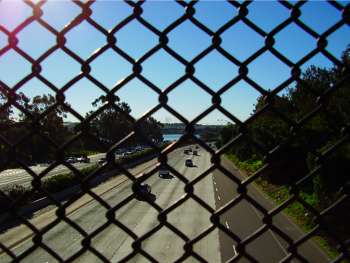Another Beautiful Ride
I'll have to find a new route now that I've probably worn out the photo opportunities on this one. Actually, next I plan on going further north on the Coast Highway and there will be some good opportunities along there. So, here are some nice sunset photos:



Friday, March 21, 2008
"A little, a little..."
There's a saying in Greek that goes "a little, a little, makes a lot." Reflective of an Orthodox understanding that the process of our salvation takes time, and little steps.
At any rate, that's become the mantra of my cycling. I keep track of my rides: distance, time, average and max speeds over at bikejournal.com (see sidebar). Depending on how you configure your journal, you have the option to track a great deal of information. The two numbers that matter to me most are distance and average speed - especially average speed over the same route. Distance is important because it tells me how hard I'm (not) working. If my distance numbers for a time period are low (like last year), it tells me I'm being lazy and not getting out there. So, although my rides are all short, its fun to watch the odometer slowly tick upwards.
The number that really means a lot to me is the average speed. Ideally you should keep your cadence to between 70 and 90 rpm. That keeps your heart rate in the right zone (no, I don't have a heart rate monitor - yet :) ), and protects your knees. Below 70 rpm you are likely "mashing" and not spinning, and that can put a lot of stress on the knee. So, to increase speed you need to gear up within that cadence range. In order to do that, you need stronger legs and greater stamina. I still stop and rest more often than I'd prefer - on the hills, that is, but less than I used to. Overall, I've been observing a steady increase in speed over the same routes. Some of this is from inflating my tires closer to their maximum, which makes the steering a bit over-responsive at speed, but reduces drag on the trike.
Today I was reminded of the "a little, a little..." maxim. I did a route I've only done once before. I ride over to Catherine's school, then uphill for quite a long time, then back down to the house. About 4.5 miles overall. Well, when I got off the trike, I saw that I had averaged only 9.1 mph, when I've been up between 9.5 and 10 on a couple of other routes (compared to 6 when I first got the trike). Well, when I compared the average to the last time I rode that route two weeks ago, I realized that I had only averaged 8.3 the last time. So real progress is being made.
In this vein, I have to share this story, from over at the recumbent blog (now added to my blogroll). Talk about someone who gets "a little, a little..." If I had taken 3 hours to ride 2 miles my first time, I don't think I would have had the character to keep after it.
Sunday, March 09, 2008
That's Not Good
I upgraded to v 2.0 of iBlog, and in the import process it seems to have ignored my cycling category. Not a big deal. The worst part of all of this is that v. 2.0, although it has many improvements over 1.0, is still at RC status, and the developer seems to have abandoned the project. Unfortunately, there also doesn't appear to be a good standalone blogging tool out there to replace it (everything else seems to require internet access, and I dislike the restrictions of that).
So, this will be a little bit of a longish post to capture some bits from the only other two entries I think I had made in this blog.
The first entry was a celebratory one when I, for the first time rode over to the beach. Its a 9 mile roundtrip, and I had always been nervous about climbing the hills back over to home. At any rate, I've now been doing that ride for about a month (on Saturday mornings). Here are some photos:




Yesterday, Catherine and I rode over to the beach together. It was pretty tough on her, but she did a good job.
The only thing of interest is the upcoming recumbent rally in Van Nuys that I'm planning on attending. You can see the details - including the ride down the coast highway here.
Friday, March 07, 2008
Catechetical Address by Patriarch Bartholomew
CATECHETICAL ADDRESS
ON THE COMMENCEMENT OFHOLY AND GREAT LENT
+ B A R T H O L O M E W
BY THE MERCY OF GOD ARCHBISHOP OF CONSTANTINOPLE
NEW ROME AND ECUMENICAL PATRIARCH
TO THE PLENITUDE OF THE CHURCH
GRACE AND PEACE FROM OUR SAVIOR AND
LORD JESUS CHRIST, AND FROM US BENEDICTION
BLESSING AND FORGIVENESS
During this period of Holy and Great Lent, our Church calls us to repentance. Doubtless, as contemporary man hears this invitation to repentance, he does not feel comfortable, because he has accustomed himself to a certain way of life, and does not wish to question his own rectitude. Calling one’s own rectitude into question produces feelings of insecurity, because the ideological structure within which you have sure and certain refuge is clearly risked.
However, a deeper examination of the issue compels us to accept that people’s convictions do not "conform to objective reality, on the basis of reasonable judgment. Rather, they create a justification that is pleasing to self, namely: excuses in sins" (Psalm 140:4). When a person justifies his or her actions and self-vindicates on the basis of erroneous values, significant harm happens, because inevitably, the moment come when the truth emerges, and we find ourselves without excuse. Moreover, there may be no more time to adjust our convictions: that is, to repent of our sinful deeds and erroneous, through which we have tried to justify our behavior.
Now as Christians, we are used to both hearing about and practicing repentance, and we do not feel a conflict with our Church’s call to repentance. However, there is a need for us to make a deliberate and conscious effort to realize that a complete repentance has two objectives.
The first objective is threefold: a renunciation of our sins, a decision to cease and desist from sinful deeds and habits, and a decision to make amends for the consequences of our sins. For example, the publican Zaccheus, who sincerely repented during his encounter with Christ, demonstrated his repentance in a practical way by repaying fourfold the very people from whom he had unjustly seized wealth.
The second objective of repentance is that we should change our mentality. We should replace our understandings with other higher and loftier ones; or in the words of the Psalmist: "to ascend in our hearts" (Psalm 83:6). This second objective needs to be pursued especially by those who are unconvinced by their consciousness about specific sins. For example, our understanding of love surely falls short of perfection; likewise our understanding of humility. For when we compare our own spiritual state to the perfection of God, a perfection we are called to imitate, surely we will see our shortcomings and realize the endless road we must traverse in order to find ourselves in the path of those who are like unto God.
As we examine the quality of our inner peace, we ascertain that we fall short of the peace of Christ "which surpasses all understanding" (Philippians 4:7). Pondering the level to which we trust our lives to God’s Providence, we sadly realize that we are often seized by anxiety and uncertainty about the future, as if we were either of little faith or even with out faith. In general, upon examination of the purity of our conscience, we realize that we fall short of understanding correctly the many feelings we harbor within ourselves that are detrimental to our purity, often mistaking them as healthy. Thus, a new and more complete enlightenment of our conscience is needed through the teachings of the Fathers and of the Gospel, so that we will be in a better position to think critically about ourselves and our shortcomings, in line with the judgment of God. Since no one can claim to judge himself perfectly, by the same token no one can claim that he has no need of a renewed mind, a more enlightened mind, a transformation of mind, a correction of mind and mentality, i.e. a need of repentance.
The call of our Orthodox Church to repentance is not merely a call to self-reproach. Self-reproach can be useful, as are deep contrition and tears of repentance; but they are not of themselves sufficient. We need to experience the joy emanating from the forgiveness granted to us by God, the sense of deliverance from the burdens of the bondage of sin, and the sense of God’s love for us. Our repentance does not deprive us from the joy of life, making us indignant at the hearing of the sermon calling to repentance. Repentance means cleansing and enlightenment of our minds, more ardent love for Christ and His creation, freedom and joy through the newness of life into which we continually enter through our constant repentance.
The one who constantly repents, ever progresses, ever rejoices through new ascents, finds constant satisfaction in deeper understandings of all things. Through the transformation of mentality and understanding, the one who repents better understands the whole world, becomes wiser, more judicious, more discreet, nobler and a true friend of Christ. Therefore, the preaching of repentance should be favorably received by wise persons who are able to appreciate any improvement that comes from the renewal of the human person through repentance.
Therefore, brothers and sisters and beloved children in the Lord, let us accept the invitation of our Church to repentance as we have set forth above. Let us who have fallen short through sin cleanse ourselves from sin through confession. Let us constantly examine our own presuppositions, so our judgments and thoughts may be godly and pure, just and true.
Finally, we paternally pray that all of you may enjoy the every assistance and help of the Lord on your road to repentance and throughout your renewed life in Christ.
Thursday, March 06, 2008
A Call for More Regulation
In response to a recall of Heparin by Baxter healthcare, Dr. West at openitstrategies has uncharacteristically called for more regulation in response to the 19 reported deaths associated with another round of tainted products from China. It may be that regulation is the solution, but I think there are probably adequate regulations in place. I want to point out what may be a couple of problems that led to this tragedy:
Problem 1:
"But sophisticated tests by Baxter and the FDA, including nuclear magnetic resonance spectroscopy and capillary electrophoresis, showed slight differences."
I have to admit that some of this article reads like the author was shilling for Baxter. Yes, by some standards these are "sophisticated" tests. You wouldn't normally do them on your kitchen counter. But I was doing NMR (nuclear magnetic resonance) in college a very long time ago. Same with electrophoretic techniques. Most newer drugs have these sorts of tests as part of their normal battery of tests. Older drugs that are covered by the U.S. Pharmacopeia often are allowed to have older, less specific tests for identity and purity (two parameters which, as I recall, need to be evaluated for all active ingredients). What would be nice is if the USP would update the testing standards for these items, and I don't think regulation is necessary for that. Its been a while since I've been around the USP and worried about the update process. I think it tends to be more reactive than proactive. Regardless, the laws (FD&C Act) and regulations (21 CFR 211) require safety and purity. Sticking with ancient assay techniques is no way to ensure safety. We know that from not so distant history. In fact, it is a standard requirement with newer drugs to have limits on unknown impurities - usually detected via things like Chromatography, Electrophoresis, NMR, or combination assays involving Mass Spectroscopy. Any of these tests, if standard, would have identified the significant contamination levels in the Heparin supply. At a previous employer, we routinely used Mass Spec as part of the release test for a drug that was still in development. Owing to the complexity of the manufacturing process, and the ever increasing sensitivity of the tests, we were frequently discovering and identifying new impurities. I don't see why similar behaviors shouldn't be the norm even for older, more established drugs. As Joel points out, its not like Baxter doesn't have the profit margin to support some additional testing.
That leads us to Problem 2:
"The news is good for Baxter as a company, says Aaron Vaughn at investment firm Edward Jones.
'Originally, it was a Baxter story. Now, it's become China supplying the U.S. market with goods that are not up to international standards,' he says."
Umm, no. Quiz time. Baxter sells a drug on the U.S. Market. Question: Who is ultimately responsible, under the FD&C act, for ensuring that the drug is safe, efficacious, and unadulterated?
Class?
Yes! Baxter. No ifs, ands or buts. I don't care who gave them the raw materials, I don't care where they came from. I don't care if the FDA was asleep at the switch somewhere. Everybody in the Pharmaceutical Quality business knows that its Baxter's problem. What kind of agreements did they have with their supplier? Didn't they need to be informed if the source of the raw materials were being changed? What sorts of auditing programs were in place to ensure the ongoing quality of the manufacturing process of the raw material (which is really an active ingredient, which enhances the level of scrutiny Baxter should give it)? These don't need to be regulated because they already are. The FDA should subject Baxter to a serious inspection, and ask some serious questions. I think there will be some significant changes at Baxter over this one - but the changes won't be in response to new regulations, they will be in response to the FDA demanding they adhere more to the ones on the books.
As noted above, it is illegal (a felony, actually) to introduce a drug into interstate commerce which is either adulterated or misbranded. This heparin was clearly adulterated. Baxter introduced it into interstate commerce. The story, and the buck, stops there.
Is the Problem Too Much Regulation?
So, after I wrote this blog entry, I came home and pulled out my USP from 1990 (translation, its been obsolete for 12 years - however I doubt that the heparin monographs have changed). The release tests for Heparin Calcium are, as follows:
Identification of Calcium (so any powder with calcium would pass here)
Pyrogenicity test - making sure it won't cause fevers in rabbits
pH - not too specific
Loss on Drying - how much water is present.
Nitrogen content
Protein Content
Heavy Metals
Anti-factor Xa Activity
So, nothing to specifically look at the structure of the molecule in question. As long as the molecular weight is similar, and it is active against Factor X, and it has Calcium, your good. So, if you close your eyes, you can hear the response from Baxter's attorneys:
"We were following the required USP testing"
"We are operating under an approved ANDA/NDA, and we can't just change tests"
"If the FDA was more active in monitoring China..."
The second statement being the one I think we'll hear. Current regulations do make it expensive to change a testing strategy. There is much lab work required, comparability studies, etc. Then you have to file the changes with the FDA and go through the approval process. Its expensive and time consuming, and will cut into profits. In other words, why would you bother? The regulations have caused stagnation. I can't put my hands on it, but back in 2003 there was an article in the Wall Street Journal pointing out that the technology used to make pharmaceutical products was far more primitive than that used to make other consumer products, like your Nike's. This is because of the regulatory hurdles that make it less competitive to improve.
Wednesday, March 05, 2008
Encyclical from our Metropolitan

ENCYCLICAL FOR GREAT LENT 2008
“The time has come-for the start of spiritual combat.
For victory over demons, for armed self-mastery.
For the comeliness of angels, for openness before God.”
(The dogmatic Hymn of Praises of Cheese Fare Sunday)
Dearly Beloved,
As we are ushered into Great Lent, the Church welcomes us with these specific, heartening and joyful expressions which carry the real meaning and definition of Lent and the fashion in which we are expected to live through it. The Church summons us to analyze and comprehend the strong meaning of the dogmatic hymn. The forty-day fast is the commencement of spiritual struggles and not a mere time span during which we are called to abstain only from certain foods, as if food is the sole culprit that leads us into sin.
We are called to abstain from all weaknesses that enfeeble and invalidate us against temptations, both spiritual and carnal, that offer us pleasure and paralyze the moral volition. We are called not to accept, but to conquer and defeat materialism, secularism and the so-called rationalistic approach of life. We are called to emulate the dignity of the angels rather that the indignity of those who have consumed their spiritual gifts and befallen to the lowest level of inanity.
It is time to reflect and to be attentive to David’s psalm which he composed after recovering from his own fall: “Man cannot abide in his pomp, he is like the beasts that perish.” (Psalm 49:12). And again, addressing the Lord with contrition: “Yet thou hast made me little less than God.” (Psalm 8:5). With these in mind, the holy hymnographer visualizes us as dignified and beautiful as the angels.
Most importantly, we are called to be sincere with God for each and every day of Lent; not concealing our real selves. It is time to believe that the Fast is the beginning of spiritual struggles against our sinful selves, which require from each one of us courage, sincerity and repentance in order to be able to pronounce: “I have sinned against heaven and before you; I am no longer worthy to be called your son.”(Luke 15:21). Only then we will be giving to God the joy to respond: “There will be more joy in heaven over one sinner who repents.”(Luke 15:17), because each one of us will be transformed into a being who had been dead and suddenly is brought to life, a lost sheep that is found and belongs to Him again.
I pray that we give this joy to God, to ourselves, and to our Holy Church during this Lenten season.
With Love in Christ,
XGERASIMOS
Metropolitan of San Francisco
